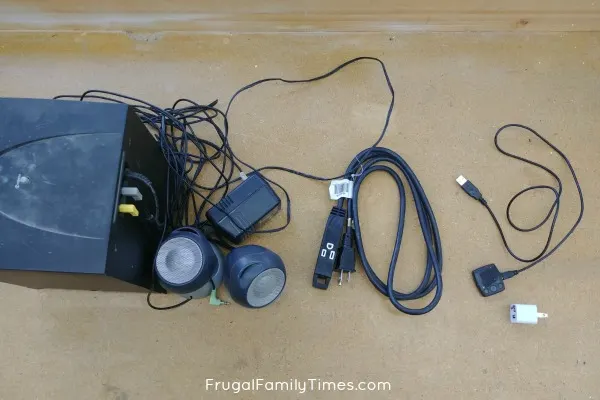We may earn a commission on purchases made after clicking links on this page.
by Ed
I have a not-very-frugal habit of shopping for technology. I am fully self-aware and I can often catch myself in a meta-I-Know-I-Don’t-Need-This-Crap-but-Want-to-Browse-Anyway moment. It hasn’t stopped me from shopping. (This is what often stops me from buying too often though.)
So this spring I was craving a newer, louder wireless speaker to listen to music at our country weekend place (our Mobile Home Makeover) and was about 30 seconds from pulling the trigger on a UE Boom 2 or Wonderboom.
But I didn’t. Instead, I wondered:
How can I make a homemade Bluetooth speaker? Can you turn wired speakers into Bluetooth?
And I dreamed up this upcycled idea: a DIY Bluetooth Speaker with Subwoofer!
I got a Bluetooth adapter in the winter, used, for about $20. It has worked really well at updating the soundbar in our DIY Hidden TV Cabinet into a wireless model to pair with our phones.
And it got me to thinking – what else could I Bluetooth myself?
While looking at my technology graveyard, in the part of the basement that Robin hates to go, I found an old computer speaker-subwoofer system and this is what I did with it. It makes a pretty cool/nerdy/fast build. So if you have a maker in your life, or you are one yourself, give it a shot.
So get out your old surround sound system – here’s how you can build your own unique new DIY Bluetooth speaker with subwoofer. A fun upcycled project!
DIY Bluetooth Speaker with Subwoofer

Here’s all the stuff for inside the speaker. I had all of it laying around, but even if you need to buy some parts, it shouldn’t cost you more than $30.
Materials to build a DIY Bluetooth Speaker with Subwoofer:
- Bluetooth adapter (Like this one)
- USB charger for Bluetooth adapter, if needed (similar to these)
- Old powered speaker system with a line-in jack – it should still work/sound good (I’ve seen lots of these available at Re-Store and other second-hand places for less than $20)
- Extension cord with 2 outlets
- Plywood to build a box to hide all the ugly. (I used the same material as our basement wood panel ceiling and our herringbone ceiling.)
- Wood Stain (I used Minwax in Early American.) and Tung Oil
Steps to Make a DIY Bluetooth Speaker with Subwoofer:
Step 1: Add Bluetooth to the speakers

This is the extension cord, with the speaker system and Bluetooth adapter plugged in and the speaker line-in connected to the Bluetooth adapter.
I then synced my phone and tested it to verify it wasn’t a pile of trash. Once you know it works, start building!

All of this ugly will hide in an attractive box and pair wirelessly with my phone.
I’m showing it here so you can fully appreciate the amount of crap that will get hidden and give you an idea for what you might have to do with your own version.
Step 2: Modify the old speakers, as needed

Optional – I started by moving the feet from the bottom to the side of my sub-woofer, because the power switch was such that I needed to change the orientation so that it was accessible after I encased everything.
You maybe won’t need to do this if your system has a different power button configuration.

Step 3: Attach Bluetooth to the Subwoofer bottom

I attached the legs to the new-bottom and fed the extension cord through.
I also positioned the Bluetooth adapter on the bottom so it would always be accessible to sync in the future.
I plugged it all in and carefully stapled the wires in place.
Step 4: Attach wires and speakers to subwoofer

The wire-spaghetti was coiled as neatly as I could make it coil (i.e. not very neat).

It is worth testing again just to verify all your cables are plugged in correctly. It is soon going to be hard/impossible to access some pieces.
Step 5: Make the DIY Wooden Bluetooth Speaker Box Face

On to the pretty stuff. Choose a hole pattern for your speaker grill. I choose a small-to-big dot pattern, but anything with enough space for sound transference will be fine.
Line it up on your face-panel and flag the centre of each dot for drilling.
Alternatively, find a fabric you can use to cover everything sound needs to pass through.

It sucked making it. But the reward is a cool, custom speaker face.

I had access to a drill press, but I still did some after with a hand drill and that is possible too.
Every couple of rows, swap out a smaller bit and make the pattern reduce down.

Don’t be rushed like me. take time to sand everything and remove all the little hole spurs. I did a less-than-thorough job and had to re-sand sections after the whole unit was assembled. Not easy.
Step 6: Assemble the Speaker Box

Check them in place by hand to make sure everything is going to fit.

I used a piece of plywood to leave a small gap at the bottom.
My subwoofer box was thick and had lots of space inside so I didn’t need to worry too much about nailing into it. Check yours before your nail.
Or better yet, use glue and clamps for a nail-hole-free look.

The hole on the back is to make the power switch accessible.
I also ended up drilling two additional ‘carrying finger holes’ near the top (not pictured yet). It totally would’ve been easier to drill at this stage… Again, learn from me.

I cut a chunk of scrap pine panel (we love using it on stuff) and cut it slightly smaller to fit inside.
This gave the box a solid top to nail into and I could just glue the final piece of panel to it for a cleaner finish.

(Yes, that’s Friday night darkness coming in the workshop window, so what? I suppose you’re hanging out with friends or family on your Friday night and not building awesome nerd projects.)

I also made the back panel with slightly more of a gap than the front and sides in order to accommodate the extension cord.

Done.
Well, almost done. I stained and sealed the unit with a dark stain finish and Tung Oil.
I suggest a toothbrush or some other small brush to use for staining the grill holes.






Wale
Tuesday 22nd of September 2020
amazing. this really helped me
frugalfamilytimes
Monday 28th of September 2020
Glad to hear it, Wale! :)
Mary
Tuesday 11th of June 2019
Sheesh, wish I could hear it! Very interesting, you are the very best nerd, keep up the good work!